
There’s something special about a country church. The sweet smell of a well-used hymnal, the creak of a pew that’s hosted generations of families, the ever-present register board showing last week’s attendance and offering amount. Often, they’re simple—wood and some basic stained glass. At least that was the aesthetic I was used to as a child at my grandmother’s church in her tiny East Texas town, population 113. It turns out that while the spirit inside is quite similar, not all country churches look the same. Some of them—like the painted churches of Texas—are absolute works of art.
Here’s a look at five of the prettiest painted churches and how they came to be.
The Artworks
Across the landscape of the Texas Hill Country, there are 20 unassuming churches a lot like the one of my childhood. On the outside, they’re white clapboard or brick. In general, they’re in unassuming towns. Sometimes in unincorporated areas with scarcely another building in sight.
But when the doors open, there’s another world inside.

Bright blue skies, shocks of pink, swirling ivy, shimmering gold, life-sized statues. The decorated interior of these magnificent buildings is a festival of colors and motifs. They’re painted with the most brilliant pigments and elaborate faux finishes. There is so much happening that the eye almost doesn’t know where to look, and, yet, it’s never garish or gaudy.
Everything in the dazzling churches was done by hand, and much of the work is 100 years old. The Czech and German immigrants who filled these pews raised money and donated materials and labor for the construction and the artwork. They oversaw–and sometimes participated in–the hand stenciling, tracing, and marbling, choosing just the right hues and accents to make these places feel even more like home.

The Artists
When most people think of Texas, Central European culture does not come to mind. But in the 1840s, German and Czech immigrants began to arrive throughout the region and settle in an area that’s roughly a 100-mile radius around Austin—a huge swath of land deep in the heart of Texas.
In search of cheap land and opportunities in the newly-christened state, they came via Bremen from northwest Germany and the provinces of Moravia and Bohemia in what is now the Czech Republic. The trip was arduous and often took as long as four months. The Czech and German immigrants left everything behind for the promise of a new, better life.

In Texas, the settlers tried to preserve their heritage, food, and values. They named their new towns Moravia, Praha (“Prague” in Czech), Weimar, and Fredericksburg after Prince Frederick of Prussia, paying homage to their homelands in middle-of-nowhere Texas. They formed civic societies and built schools to maintain their language and customs.
As they prospered, the settlers sacrificed and saved to build new places of worship that reminded them of their homeland. Having a church was a milestone showing that they had succeeded. They rejoiced, decorating the interior in the sumptuous colors and designs of what they had left behind. It did not matter that paint was used to achieve the effect of carvings, marble, and gold—the churches were theirs, and they were beautiful.
Inside the Painted Churches of Texas
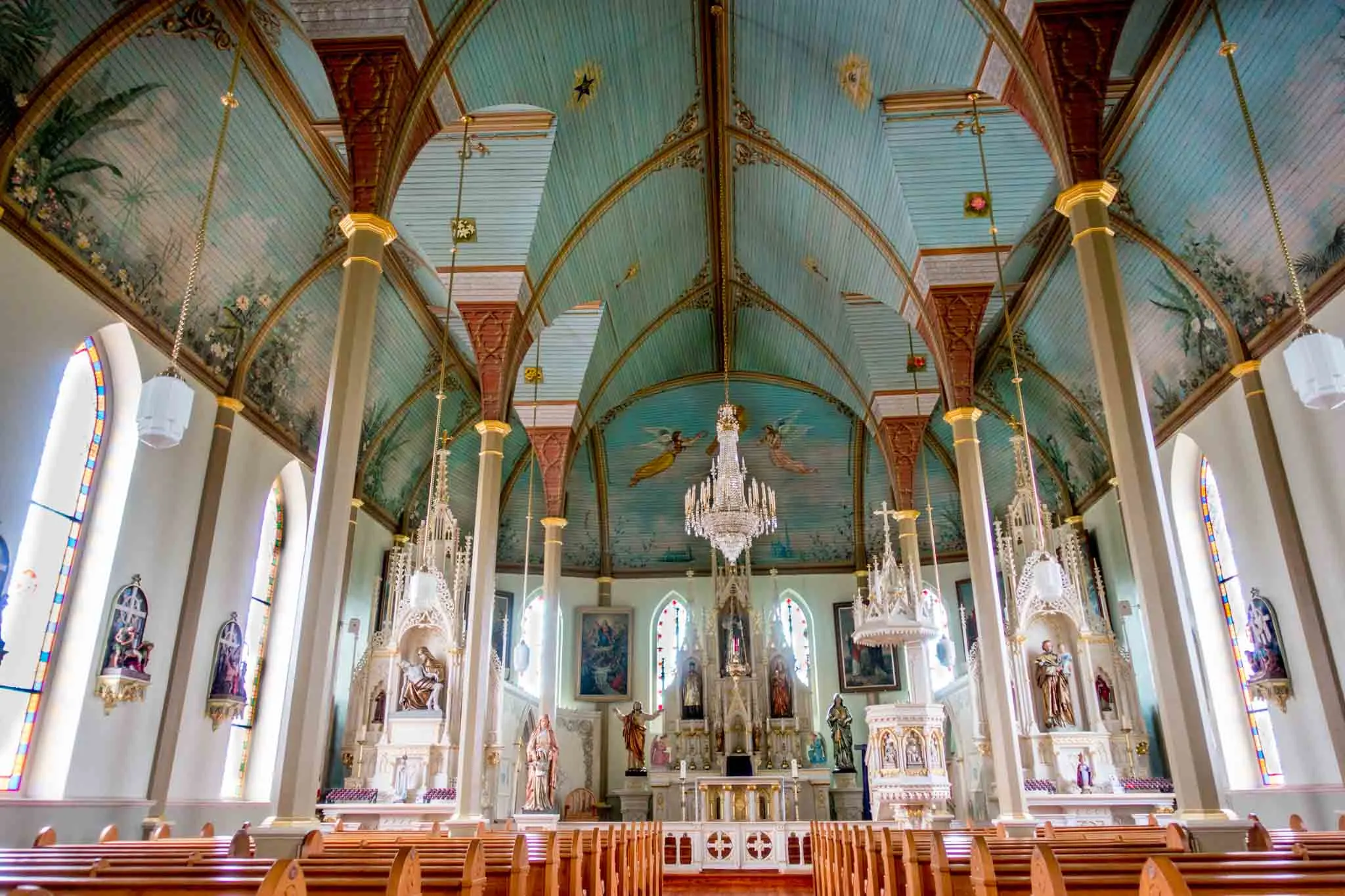
The 20 painted churches of Texas, all inscribed in the National Register of Historic Places, are scattered throughout Central Texas. Four of these lovely buildings are located near each other and are easily accessible to the public. Although they’re all in different tiny towns (like Dubina, population 44), they are informally known as the painted churches of Schulenburg, which is the largest town nearby.
About 80 miles southeast of the capital, visiting the churches near Schulenberg makes for an easy day trip from Austin. On the opposite side of Austin, Fredericksburg is also home to a painted church that is easy to visit most days of the week. Take a look inside these five sensational buildings, which can be visited in a fun road trip across Central Texas.
St. John the Baptist
Google address: 7850 Mensik Rd in La Grange
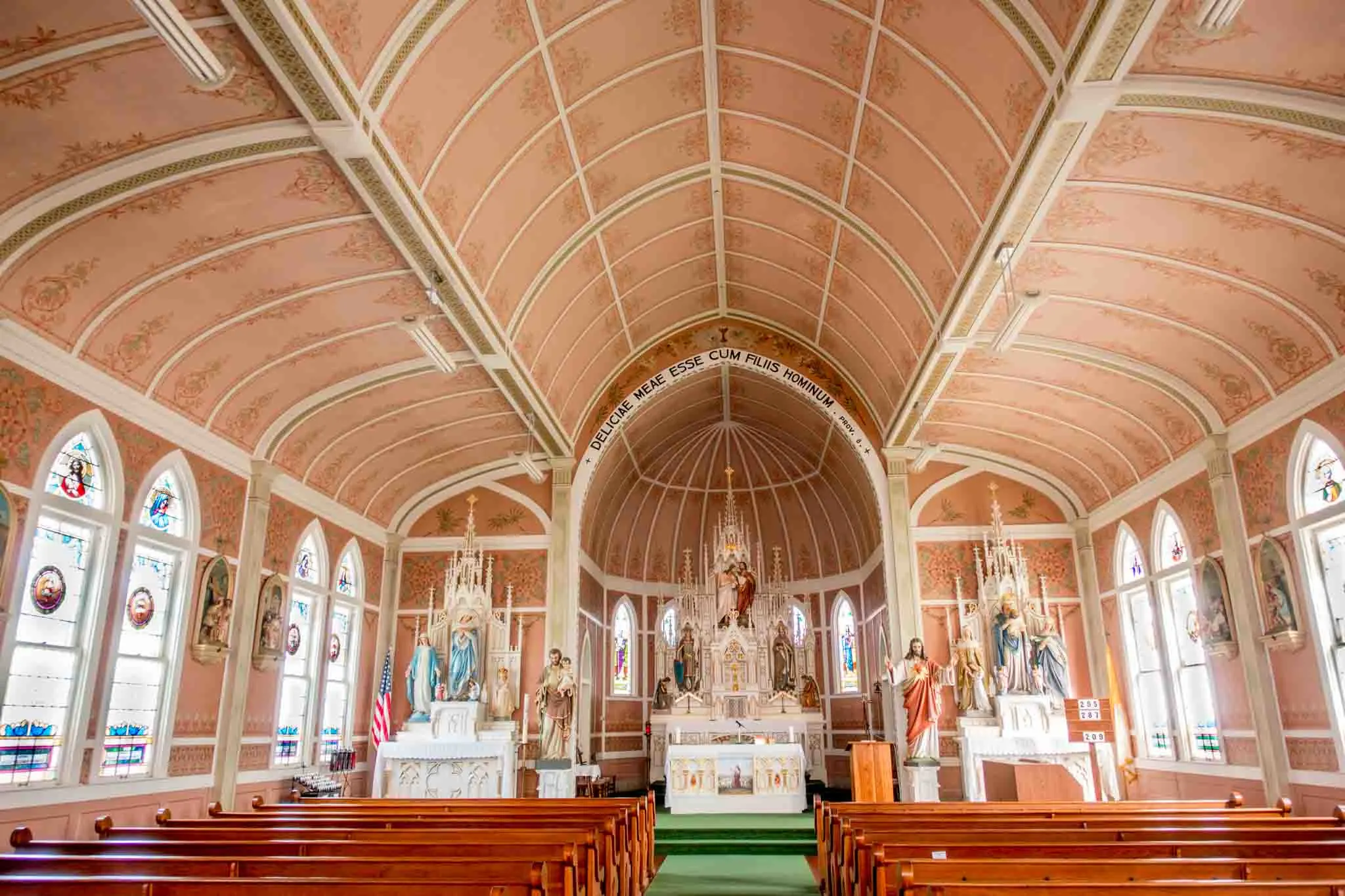
Arriving from Austin, the first painted church I visited was a surprise in dusty rose. The entire sanctuary of St. John the Baptist in Ammannsville is painted a deep shade of pink, accented by pink and green ivy and designs. While the color itself is attention-getting, it is also a magnificent canvas for the many statues around the sanctuary.


St. John the Baptist, built in 1919, is the third church in this spot. The first, built in 1890, was destroyed by a tornado in 1909, and the second burned down in 1917. Rebuilding a third time shows just how important the presence of a church was to the small town. It could not have been easy to raise the funds three times in less than three decades.
The Gothic Revival building reflects the design aesthetic of both the congregation’s German and Czech members. Floor-to-ceiling decorative elements pleased the Germans, and the mostly clear windows pleased the Czechs because they allowed light in. Several of the original statues and a cross saved from the fire pay tribute to the past and the resilience of the community.
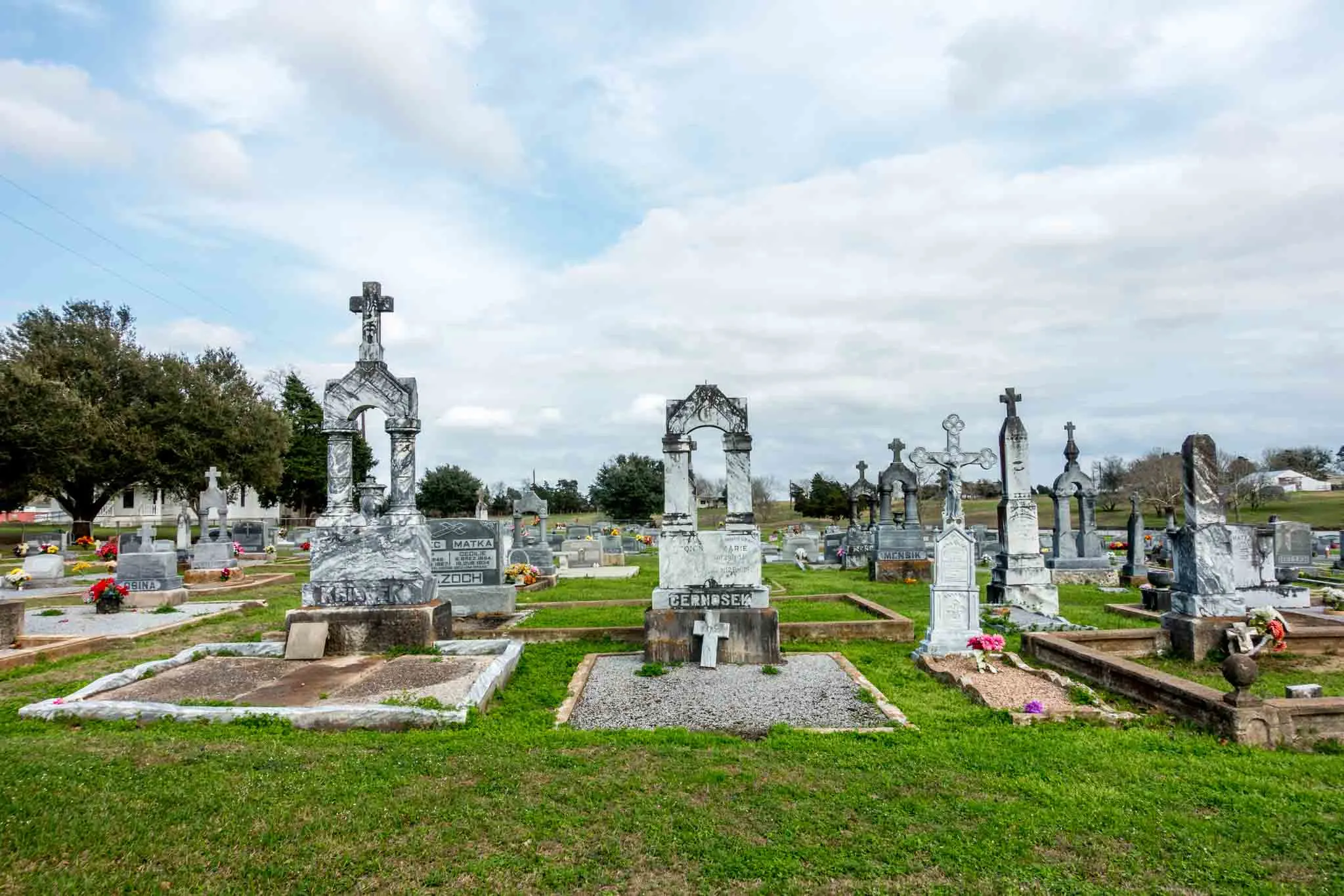
Just outside, the cemetery is clearly European-influenced and reminded me of our day at the famous Bone Church in Kutna Hora near Prague. Great marble and metal crosses rise beyond eye-level. Many of the old tombstones have inscriptions in Czech and include birthplaces a continent away.
Saints Cyril and Methodius Church
Google address: Location: 4148 FM 1383 in Dubina
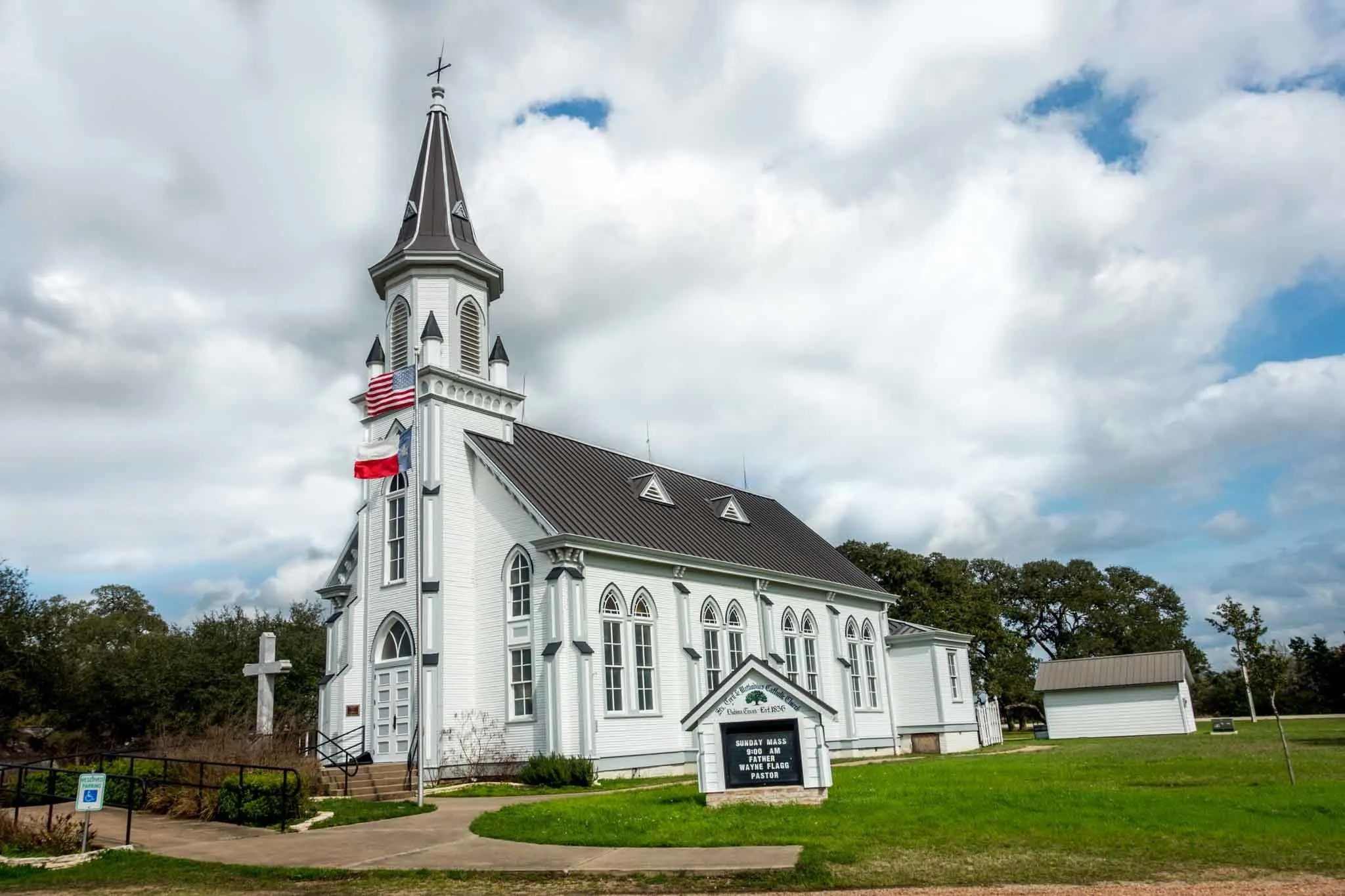
From the moment I pulled up to Saints Cyril and Methodius Catholic Church, everything felt familiar. The crunch of the gravel and the white church standing alone just off the road are characteristic of many small towns in Texas. For a minute, I was afraid it would be closed because there were no other cars around.
Despite being alone, I was relieved to find the door unlocked. It opened to reveal the bluest indoor sky I’ve ever seen.
The path to this remarkable work of art was a long one. Settled in 1856, Dubina is known as the “Mother of Czechs in Texas.” Its first church followed 21 years later but was destroyed by a hurricane in 1909. The current one replaced the original in 1912.
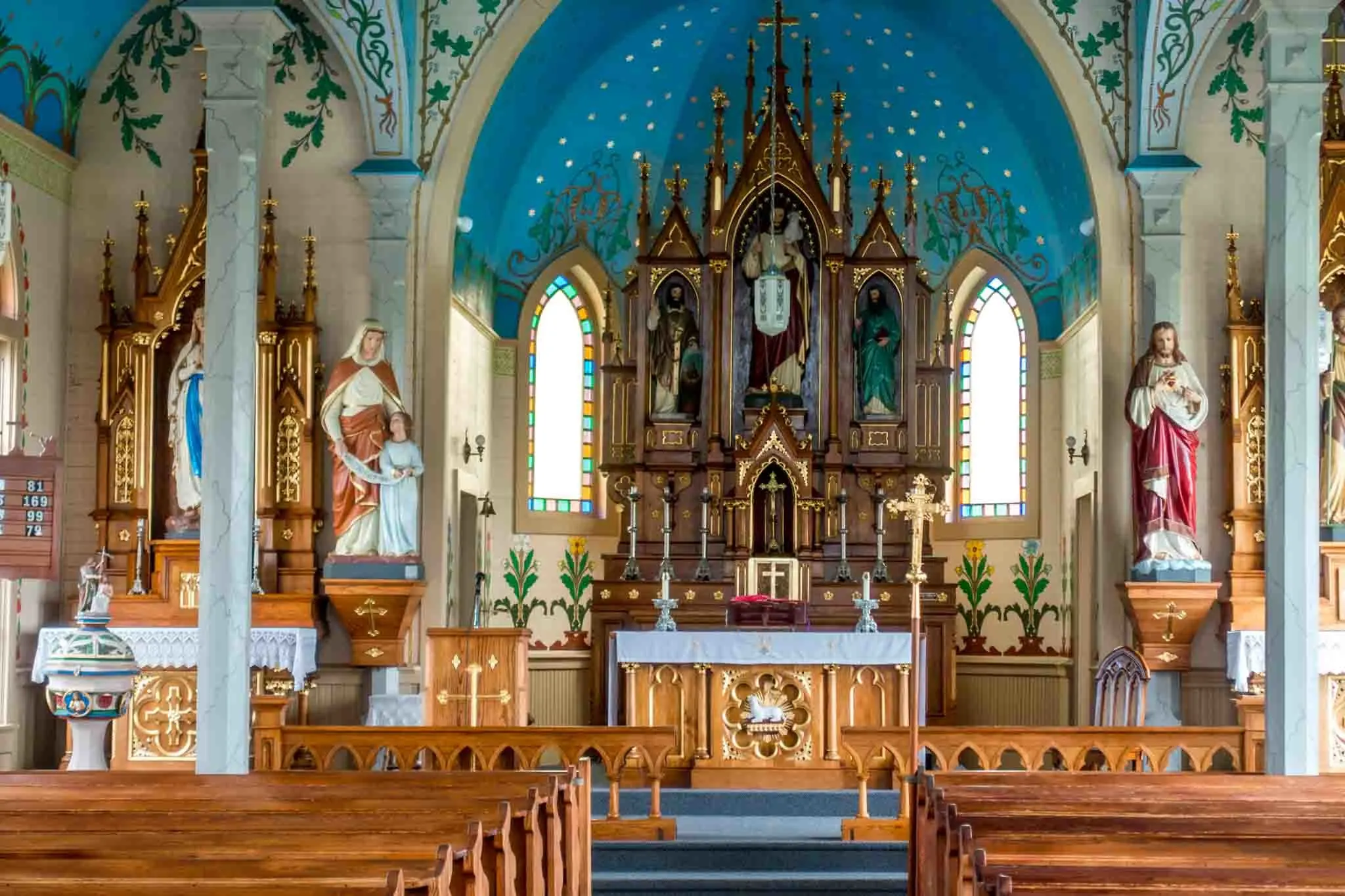
The simple exterior of Saints Cyril and Methodius is topped with the same iron cross that graced the steeple of its predecessor—a work forged by Tom Lee, a former slave who lived in the area. Inside, the bright colors of the sanctuary have been restored to their original glory. The designs had been white-washed over in the 1950s when the diocese thought they were too distracting, but a restoration effort in 1983 brought them back to life.
Today you can see the blue vaulted ceiling gleaming with gold stars, floral stenciling, and angels watching from high above. Even without the lights on, the interior feels illuminated thanks to the basic windows that let in all the light possible.
At the edge of the entryway, a locked gate keeps visitors outside the sanctuary when it’s not in use. Even with the limited access, it’s still a spectacular view.
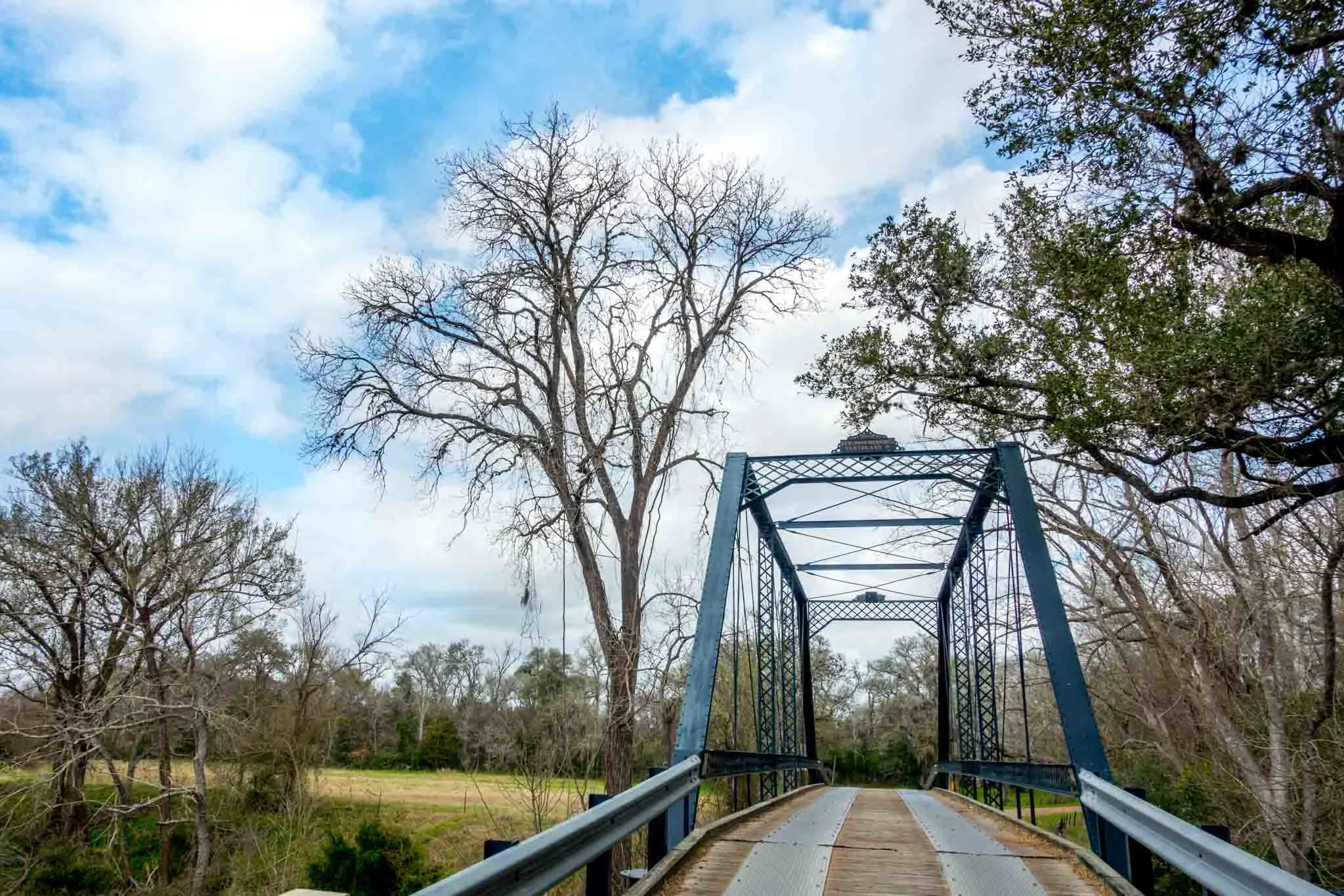
The easiest way to reach the next stop is by taking Piano Bridge Road (clearly visible from the church). Just one-half mile down the road, the Piano Bridge is one of only a few remaining iron bridges in the US. It dates from 1885 and reportedly got its name because of the noise it made when cars drove over it. A renovation has silenced the bridge’s music and despite the “weak bridge” sign, it is well-used by locals.
St. Mary’s (High Hill)
Google address: 2833 FM 2672 in Schulenburg

St. Mary’s Catholic Church in High Hill is breathtaking. It feels like every inch of this red-brick building is painted, gilded, or adorned in some way. At just six miles from Saints Cyril and Methodius Church, visiting here is a must, even if you’re short on time.
Nicknamed the “Queen of the Painted Churches” in Fayette County, St. Mary’s dates from 1906. Its abundant paintings were added in 1912, and a 2011 renovation restored them to their original glory.


The German community in High Hill built this large Gothic Revival-style church to accommodate its ever-expanding population and filled it with intricate stained glass from Germany, outstanding statues, and remarkable paintings. In addition to its elaborate altar, the church also features a painted reproduction of Michelangelo’s Pietà sculpture. Even the vestibule is decorated—Bible verses in German trace the walls.
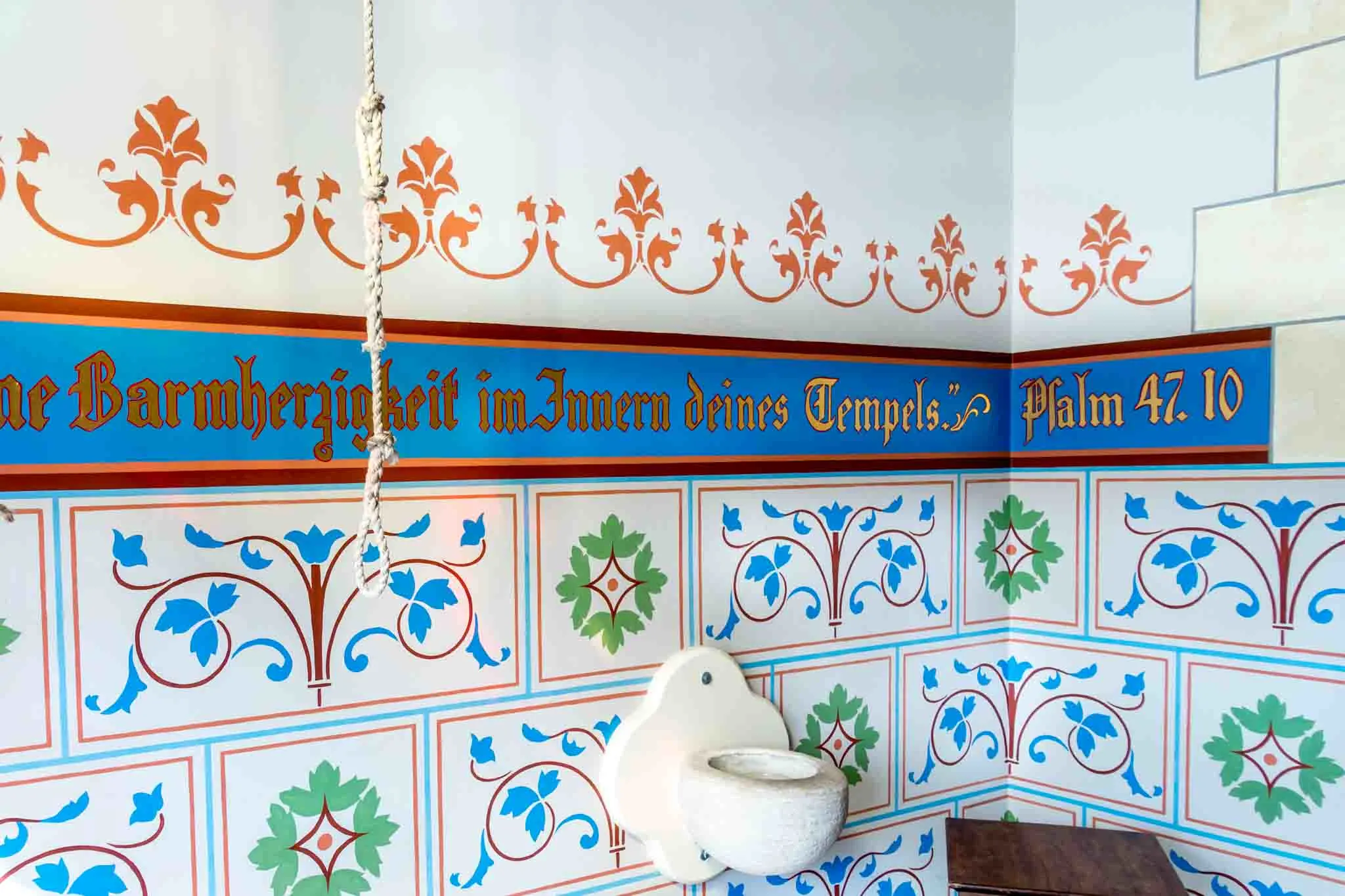
One of the most unusual things about St. Mary’s is that the light blue wash and scrollwork that contribute to the majesty of the sanctuary are not actually painted on the ceiling. Instead, the painting was done on canvas that was attached to the wooden ceiling. The canvas, which gives the appearance of vaulting, and a faux marble finish on the columns add other interesting visual elements.
St. Mary’s Church of the Assumption
Google address: 821 FM 1295 in Flatonia

As with the other unique churches, the exterior of St. Mary’s Church of the Assumption in Praha gives no indication of the beauty inside. From its carillon that rings three times daily to its shimmering statues and pulpit, it is distinctly unlike my grandmother’s country church in every way.
Built in 1895, St. Mary’s is one of the oldest painted churches and the first Catholic church in Texas with a predominantly Czech congregation. With over 200 families in the area, the parishioners had already outgrown their two previous chapels when they decided to build the yellow stone church.

St. Mary’s was designed in the popular Gothic Revival style of the time. The flowers, palms, and stars that grace the ceiling and walls were painted by Swiss fresco artist Gottfried Flurry. His trompe l’oeil designs mimic vaults, relief, and marble that would be seen in the ancient churches of Europe.

Like the other painted churches, St. Mary’s has an array of statues of saints and sconces featuring the stations of the cross. The true star of the building is its beautiful white altar gilded in 24 karat gold.
Although Praha is now essentially a ghost town, its population expands by as much as 5000 once a year. Every August 15th, St. Mary’s hosts the parish’s annual homecoming for residents, former residents, and generations of extended families.
St. Mary’s (Fredericksburg)
Google address: 304 W San Antonio St. in Fredericksburg

About 80 miles west of Austin is another of the painted churches of Texas, St. Mary’s in Fredericksburg. The setting of this St. Mary’s could not be more different than that of the Schulenburg churches—Fredericksburg is a charming town of 10,000 residents that’s full of award-winning wineries, shops, outdoor activities, and lots of other fun things to do. It’s one of my favorite places in Texas.
St. Mary’s began in 1846 with a group of German settlers, and like its counterpart in Praha, quickly outgrew its original building. The new building was designed in 1908 by San Antonio architect Leo M.J. Dielmann (he also designed High Hill). The Fredericksburg community raised $40,000 (equivalent to $1M today) to build their stone Gothic Revival building.

Almost no expense was spared on St. Mary’s, whose design incorporates a corner tower, buttresses, and other Gothic features along with stained glass from Germany. The church still has its original pipe organ, which has since been completely electrified. Stenciling was added in 1936 along with paintings of the 12 apostles throughout the sanctuary.

Visiting the Churches
All the churches conduct regular Mass Services, which are generally Saturday afternoon and Sunday morning (daily at St. Mary’s, Fredericksburg). They are also open during the day for self-guided tours. Many have pamphlets that provide background on their history. For a more in-depth experience, the Schulenburg Chamber of Commerce runs tours of the four churches in that area.
Laura Longwell is an award-winning travel blogger and photographer. Since founding Travel Addicts in 2008, she has written hundreds of articles that help over 3 million people a year get the most out of their travel. In that time, she has visited nearly 60 countries on 5 continents, often returning to favorite destinations over and over again. She has a deep love of history, uncovering unexpected attractions, and trying all the good food a place has to offer.
In addition to Travel Addicts, Laura runs a site about her hometown of Philadelphia—Guide to Philly—which chronicles unique things to do and places to see around southeastern Pennsylvania. Her travel tips and advice appear across the web.


Thomas Mitchell Rosenquist
Tuesday 10th of January 2023
Truely, these churches are Texas treasures!!! They just don't build and decorate churches like this anymore!! Please be sure and make a donation to the upkeep and restoration of any churches you visit!!! It is an investment in the preservation of Texas history and artistic beauty.
Kristin
Sunday 13th of November 2022
Im so excited to find this article Im taking my daughter for her 17th birthday this December she loves art and statues and ask to go to some museums and I ran across this article we are coming from Gatesville TX cant wait for this adventure
Laura Longwell
Sunday 13th of November 2022
Enjoy! They're uniquely beautiful places.
Pat Bass
Friday 13th of May 2022
Are "geo coordinates" available for the church locations?
Linda Woodson
Sunday 1st of May 2022
Laura, We have seen the Schulenburg Painted Churches and St. Mary's in Fredericksburg. Where are the other 14 painted churches? I can't seem to find them.
Linda
Laura Longwell
Tuesday 3rd of May 2022
I saw the complete list several years ago, but I haven't been able to find it again.
Brenda
Saturday 26th of February 2022
Please visit St Michael church in Weimar TX. Most beautiful!